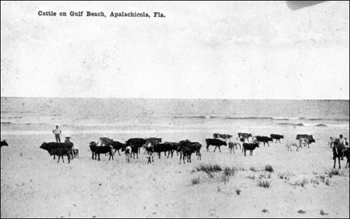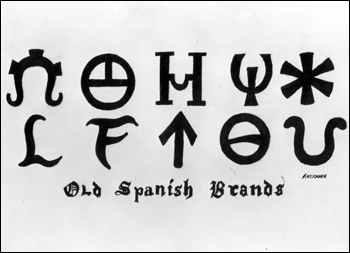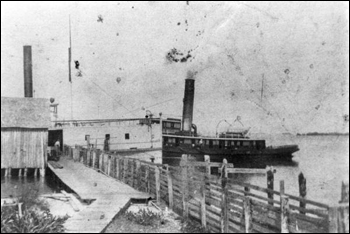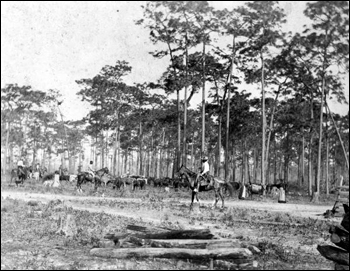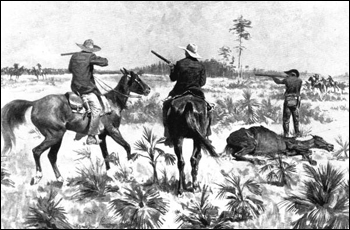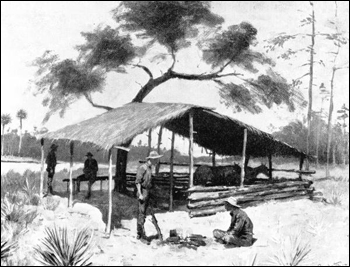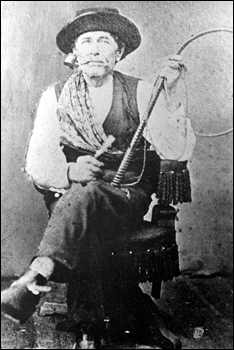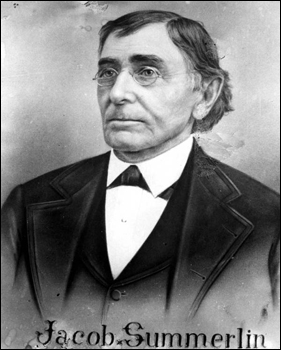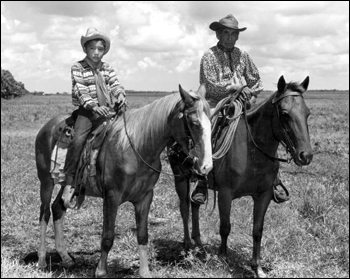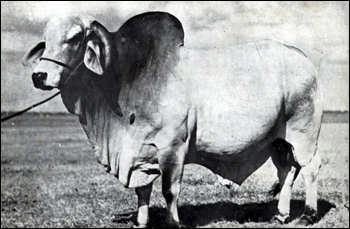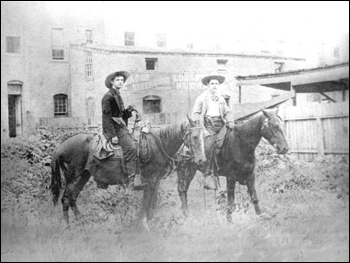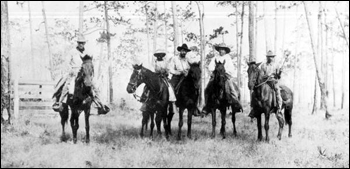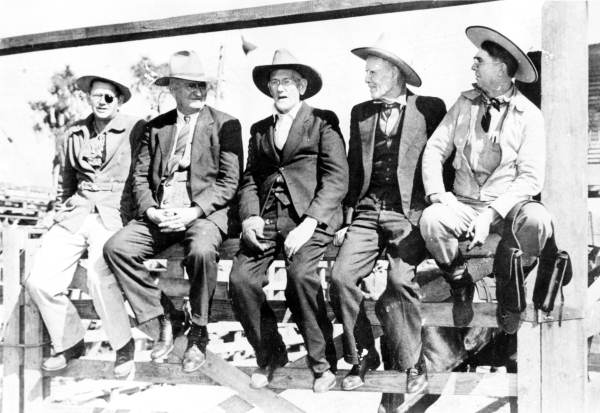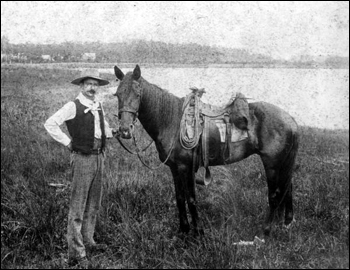Photo Exhibits
Photo exhibits spotlight various topics in Florida history, and are accompanied by brief text intended to place selected materials in historical context.
Florida Cattle Ranching
Cow Hunters and Cattle Barons
Florida has the longest history of ranching of any state in the United States. This exhibit celebrates that long history and the continuing importance of cattle and ranching to the Florida economy and culture. This exhibit is presented in support of the Florida Folklife Program exhibit, Florida Cattle Ranching: Five Centuries of Tradition, currently on display at the Western Folklife Center, Elko, Nevada from January 18 - July 24, 2010. Images from the State Archives are used, along with information from the exhibit and new photographs from folklorist Bob Stone, to illustrate how cattle, the people who raise them, and the cultural importance of ranching have changed since cattle first arrived with the earliest Spanish explorers more than 400 years ago. This exhibit showcases the work, play, tradition, and artistry that ranching represents in Florida.
Special thanks to Tina Bucuvalas and Bob Stone of the Florida Folklife Program, co-curators of the Florida Cattle Ranching exhibit, who provided the historical background and Bob Stone's own images for this presentation.
Cattle on the beach: Apalachicola, Florida
Image Number: N047144
Old Spanish cattle brands
Image Number: RC05555
Florida Cattle Ranching: Five Centuries of Tradition
Florida's cattle industry, one of the oldest and largest in the nation, is vital to the state's well-being. Ranching is an essential economic activity that preserves many aspects of the natural landscape, protects water resources, and maintains areas used by wildlife or for recreation. Yet few know about Florida's unique ranching traditions, which have been adapted to the subtropical climate and influenced by the state's distinctive history.
In Florida, those who own or work cattle traditionally have been called cowmen. In the late 1800s they were often called cow hunters, a reference to hunting for cattle scattered over the wooded rangelands during roundups. At times the terms cowman and Cracker have been used interchangeably because of similarities in their folk culture. Today the western term "cowboy" is often used for those who work cattle.
Steamship at wharf: Punta Rassa, Florida (189-)
Image Number: RC19392
Wharf where cattle were hurriedly pushed along chutes and crowded into every available spot on board schooners that plowed the waters between Punta Rassa, Tampa, St. Andrews Bay, Charlotte Harbor, and Cuba. Many ships carried 200 head or more per trip.
Cattle drive at Bartow (189-)
Image Number: RC02673
At the far left is Crayton Parker, in the middle is Tom Smith on a horse named Boomerang, and at the right is Aunt Jeanie feeding hay to a cow.
Colonial Florida
Florida ranching has evolved from many different cultural traditions, though the most important sources were the marshy coastal areas of Andalusia, Spain, and the hill regions of Britain and Ireland. In Andalusia, ranchers living in towns hired cow hands (vaqueros), who marked or branded the cattle, managed them from horses, and moved them to different locations during the year. They later brought long-horned Andalusian cattle to the Americas. In highland Britain and Ireland, herders marked or branded cattle for identification, penned them at night for protection, and moved them to different pastures during the year. In the fall, the animals were sold to drovers, who used dogs and whips to drive them to markets or slaughterhouses. The Spanish and British took these traditions to the West Indies, where they were adapted to the tropical climate and combined to create ranching systems used throughout the Americas.
Florida's Andalusian/Caribbean cattle were the first in today's United States. Some scholars believe that cattle brought by the expeditions of Ponce de Leon in 1521 and Don Diego de Maldonado in 1540 escaped and survived in the wild. Organized ranching began with the founding of St. Augustine in 1565, when cattle from Spain and Cuba formed the basis of herds that fed the garrison and surrounding communities. In addition to herds owned by the Spanish and Indians, wild cattle flourished in the rangelands and prairies. Eventually Spanish colonists began exporting cattle to Cuba. During the 1600s, Spanish clergy raised cattle at the missions, where many Native Americans learned to tend them.
Cowboy at an open range roundup near Fort McCoy: Florida (c. 1910)
Image Number: N045020
Image Number: RC02054
Included in an article titled "Cracker Cowboys of Florida" published in Harper's New Monthly magazine v.91, issue 543, August 1895.
Cows and Empires
By 1700, Florida contained approximately 34 ranches and 20,000 head of cattle. After British-Creek Indian raids in 1702 and 1704 devastated Florida cattle ranchers, Indians sustained cattle raising in Florida. Many had established large herds of wild cattle and stock acquired from the Spanish. Cattle herding was vital culturally and economically to the early Seminoles, as attested to by the name of their leader, Cowkeeper (ca. 1710-1783). They remained Florida's major livestock producers throughout most of the 1700s.
During British rule (1763-1783), English planters and Creek Indians in west Florida owned substantial herds. Cowmen from Georgia and the Carolinas spread into north Florida during that period.
In early Florida, Europeans, Americans, and Indians stole cattle from each other. Rustling became particularly widespread by the second half of the 18th century, and was one of the elements that led to the Seminole Wars.
Image Number: RC02057
Included in an article titled "Cracker Cowboys of Florida" published in Harper's New Monthly magazine v.91, issue 543, August 1895.
Image Number: RC02467
He amassed a fortune in the cattle business and endowed the Summerlin Institute.
Jacob Summerlin (1820-1893). Reputedly the first child born in the Florida Territory, Jake Summerlin was said to have started working cattle and cracking whips by seven years of age. At 16, he travelled south to central Florida, where he earned his fortune raising cattle in the Kissimmee and Peace River areas. Summerlin became one of the state's wealthiest men before he reached 40. He and his partners sold cattle to Cuba and the U.S. Naval Base in Key West. He purchased large land parcels in southwest Florida, including a wharf at Punta Rassa. During the Civil War, Summerlin smuggled beef to the Confederates by shipping it out of present day Charlotte Harbor, then later sold cattle to Union soldiers at Ft. Myers. After the war he donated land to establish a school in Bartow. In Orlando, he opened the Summerlin Hotel, donated the land for Lake Eola Park, and became the City Council's first president.
Jacob Summerlin: Bartow, Florida
Image Number: RC12095
He amassed a fortune in the cattle business and endowed the Summerlin Institute.
Seminole Indian cowboy Charley Micco and grandson Fred Smith on horseback in a cattle ranch: Brighton Reservation, Florida. (1950)
Image Number: C013676
The 19th Century: Struggle and Sacrifice
When the U.S. took possession of Florida in 1821, it was described as a "vast, untamed wilderness, plentifully stocked with wild cattle." Florida "scrub" or Cracker cattle were descended from the mix of Spanish and British breeds. These hardy creatures survived on native forage, tolerated severe heat, insect pests, and acquired immunity to many diseases.
Early Florida cowmen survived in difficult conditions. They fought off panthers, wolves, bears, and cattle rustlers. Cowmen spent weeks or months on cattle drives across difficult marshes and dense scrub woods, often enduring burning heat, torrential thunderstorms, and hurricane winds. From central Florida they sometimes drove cattle as far as Jacksonville, Savannah, and Charleston. This gradually changed in the 1830s when the cattlemen re-established trade with Cuba, and Tampa, Punta Gorda, and Punta Rassa became important export ports.
The number of cattle increased rapidly from the 1840s until the Civil War. Florida was second only to Texas in per capita value of livestock in the South. After the Armed Occupation Act of 1842, cattlemen from the overstocked states of Georgia, Alabama, and the Carolinas homesteaded 200,000 acres in Florida. Some seized range territory that the Seminoles had been forced to relinquish as a consequence of the Seminole Wars. The newcomers often brought foundation herds that interbred with wild scrub cattle. Few cattlemen owned grazing land since there was extensive open range. By mid-century, ranchers were running large herds on the extensive open range in central and south Florida.
Wars provided an economic boost for Florida cattlemen, who provisioned armies during the Seminole, Civil, and Spanish American Wars. Although the Civil War disrupted the Cuban trade, Florida cowmen became beef suppliers to both armies. Hides, tallow, and meat from Florida were so important for the Confederacy that a Cow Cavalry was organized to protect herds from Union raiders.
After the Civil War there were still wild cattle in Florida, as well as attractive markets to the north and south. During the next three decades, trade boomed with Cuba, Key West, and Nassau, and Florida became the nation's leading cattle exporter. From 1868 to 1878, ranchers received millions of dollars in gold doubloons for over 1.6 million cattle exported to Cuba. The Cuban commerce provided income to cattlemen, merchants, and shippers, and contributed to the state's recovery from Reconstruction-era depression.
Emperor: registered Guzerat Brahman bull bred and raised on the ranch of Henry O. Partin and sons, Kissimmee, Florida
Image Number: PC4977
Brahman bull: Bradenton, Florida
Image Number: PC5941
Accompanying note: "Emperor Jr. 10th owned by T.P. Chaires Jr. of Bradenton, Florida. One of the outstanding Brahman Bulls in Florida. This is the second generation of Florida bred cattle imported from India. Florida rates second in the U.S. in pure bred Brahman cattle."
Two cowboys wearing handguns: Gainesville, Florida (189-)
Image Number: RC05578
Rough and Ready, two cowboys wearing handguns and boots, are two Gainesville residents. Archie L. Jackson, left, was the son of a Confederate veteran and grandfather of an Alachua County rancher. Thomas McDonald, right, had a son, Harrison H. McDonald, who was a county judge for many years. This photo was taken in the 1890s, after the two men had driven a herd of cattle from Old Town, forded the Suwannee River, and brought the herd close to Gainesville for grazing. This shot was taken about one block west of the courthouse, behind Steenberg's Hardware Store, later Thomas Hardware.
Cowboys on Mr. Burt's Spring Garden Ranch: De Leon Springs, Florida (1917)
Image Number: RC11292
Group of Florida cattle barons - De Soto County, Florida
Image Number: PR02701
L-R: Ed Wells, C. C. Carlton, W. N. "Pole" Duncan, Hooker Parker, unknown.
Tom Johnson holding the reins of his horse: Orlando, Florida (189-)
Image Number: RC02505

 Listen: The Gospel Program
Listen: The Gospel Program